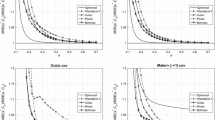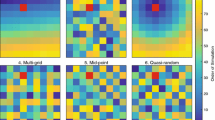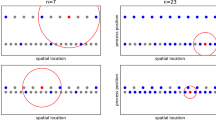Abstract
Gaussian random field (GRF) conditional simulation is a key ingredient in many spatial statistics problems for computing Monte-Carlo estimators and quantifying uncertainties on non-linear functionals of GRFs conditional on data. Conditional simulations are known to often be computer intensive, especially when appealing to matrix decomposition approaches with a large number of simulation points. This work studies settings where conditioning observations are assimilated batch sequentially, with one point or a batch of points at each stage. Assuming that conditional simulations have been performed at a previous stage, the goal is to take advantage of already available sample paths and by-products to produce updated conditional simulations at minimal cost. Explicit formulae are provided, which allow updating an ensemble of sample paths conditioned on \(n\ge 0\) observations to an ensemble conditioned on \(n+q\) observations, for arbitrary \(q\ge 1\). Compared to direct approaches, the proposed formulae prove to substantially reduce computational complexity. Moreover, these formulae explicitly exhibit how the \(q\) new observations are updating the old sample paths. Detailed complexity calculations highlighting the benefits of this approach with respect to state-of-the-art algorithms are provided and are complemented by numerical experiments.





Similar content being viewed by others
References
Barnes RJ, Watson A (1992) Efficient updating of kriging estimates and variances. Math Geol 24(1):129–133
Binois M, Ginsbourger D, Roustant O (2014) Quantifying uncertainty on Pareto fronts with Gaussian process conditional simulations. Eur J Oper Res. doi:10.1016/j.ejor.2014.07.032
Chevalier C (2013) Fast uncertainty reduction strategies relying on Gaussian process models. Ph.D. Thesis, University of Bern, Bern
Chevalier C, Ginsbourger D, Emery X (2014) Corrected kriging update formulae for batch-sequential data assimilation. In: Pardo-Igúzquiza E et al (eds) Mathematics of planet Earth. Springer, Berlin, pp 119–122
Chilès JP, Allard D (2005) Stochastic simulation of soil variations. In: Grunwald S (ed) Environmental soil-landscape modeling: geographic information technologies and pedometrics. CRC Press, Boca Raton, pp 289–321
Chilès JP, Delfiner P (2012) Geostatistics: modeling spatial uncertainty, 2nd edn. Wiley, New York
Davis MW (1987) Production of conditional simulations via the LU triangular decomposition of the covariance matrix. Math Geol 19(2):91–98
de Fouquet C (1994) Reminders on the conditioning kriging. In: Armstrong M, Dowd P (eds) Geostatistical simulations. Kluwer Academic Publishers, Dordrecht, pp 131–145
Delhomme J (1979) Spatial variability and uncertainty in groundwater flow parameters: a geostatistical approach. Water Resour Res 15(2):269–280
Deutsch C (2002) Geostatistical reservoir modeling. Oxford University Press, New York
Dimitrakopoulos R (2010) Advances in orebody modelling and strategic mine planning. Australasian Institute of Mining and Metallurgy, Spectrum Series 20, Melbourne
Emery X (2009) The kriging update equations and their application to the selection of neighboring data. Comput Geosci 13(1):211–219
Emery X, Lantuéjoul C (2006) Tbsim: a computer program for conditional simulation of three-dimensional Gaussian random fields via the turning bands method. Comput Geosci 32(10):1615–1628
Gao H, Wang J, Zhao P (1996) The updated kriging variance and optimal sample design. Math Geol 28:295–313
Ginsbourger D, Baccou J, Chevalier C, Perales F, Garland N, Monerie Y (2014) Bayesian adaptive reconstruction of profile optima and optimizers. SIAM J Uncertain Quantif 2(1):490–510
Handcock MS, Stein ML (1993) A Bayesian analysis of kriging. Technometrics 35(4):403–410
Hernández J, Emery X (2009) A geostatistical approach to optimize sampling designs for local forest inventories. Can J For Res 39:1465–1474
Hoshiya M (1995) Kriging and conditional simulation of Gaussian field. J Eng Mech 121(2):181–186
Journel A, Huijbregts C (1978) Mining geostatistics. Academic Press, London
Journel A, Kyriakidis P (2004) Evaluation of mineral reserves: a simulation approach. Oxford University Press, New York
Lantuéjoul C (2002) Geostatistical simulation: models and algorithms. Springer, Berlin
Matheron G (1973) The intrinsic random functions and their applications. Adv Appl Probab 5(3):439–468
O’Hagan A (1978) Curve fitting and optimal design for prediction. J R Stat Soc Ser B (Methodol) 40(1):1–42
Omre H, Halvorsen K (1989) The Bayesian bridge between simple and universal kriging. Math Geol 22(7):767–786
Roustant O, Ginsbourger D, Deville Y (2012) Dicekriging, diceoptim: two R packages for the analysis of computer experiments by kriging-based metamodelling and optimization. J Stat Softw 51
Santner TJ, Williams BJ, Notz W (2003) The design and analysis of computer experiments. Springer, Berlin
Stein ML (1999) Interpolation of spatial data: some theory for kriging. Springer, New York
Villemonteix J, Vazquez E, Walter E (2009) An informational approach to the global optimization of expensive-to-evaluate functions. J Global Optim 44(4):509–534
Acknowledgments
Part of this work has been conducted within the frame of the ReDice Consortium, gathering industrial (CEA, EDF, IFPEN, IRSN, Renault) and academic (Ecole des Mines de Saint-Etienne, INRIA, and the University of Bern) partners around advanced methods for Computer Experiments. Clément Chevalier warmly thanks Prof. Julien Bect for fruitful discussions on GRF simulation. David Ginsbourger acknowledges support from the Department of Mathematics and Statistics of the University of Bern and from the Integrated methods for stochastic ensemble aquifer modelling (ENSEMBLE) project funded by the Swiss National Science Foundation under the contract CRSI22_12249/1. The authors are indebted to two anonymous referees, an associate editor, and Yves Deville for a number of remarks having contributed to substantially improve the paper.
Author information
Authors and Affiliations
Corresponding author
Appendices
Appendix A: Universal and Simple Kriging
Let \(Z\) be a \(L^2\) random field defined on a bounded set \(\mathbb {X}\subset \mathbb {R}^d\) with known (and not necessarily stationary) covariance function \(k(\cdot ,\cdot )\) and unknown mean function \(m(\cdot )\) such that \(Z|m \sim \text {GRF}(m,k)\), where \(\text {GRF}(m,k)\) denotes a GRF with mean function \(m\) and covariance function \(k\). A well-known Bayesian approach consists in writing \(m\) as follows
where \(\ell \ge 1\), \(f_1,\ldots ,f_\ell \) are \(\ell \) known basis functions and \(\varvec{\beta }= (\beta _1,\ldots ,\beta _\ell )\) has an improper uniform prior in \(\mathbb {R}^\ell \). In these settings, known as the universal kriging settings, when \(n\) observations \(Z(\mathbf {x}_{1:n})\) are assimilated at points \(\mathbf {x}_{1:n} := (\mathbf {x}_1,\ldots ,\mathbf {x}_n)\in \mathbb {X}^n\), it is known (O’Hagan 1978) that the posterior distribution of \(Z\) is a GRF with posterior (or conditional) mean function \(m^{UK}_n\) and covariance function \(k^{UK}_n\) given by the so-called universal kriging equations
where \(\widehat{\varvec{\beta }} := (\mathbb {F}^\top K^{-1} \mathbb {F})^{-1}\mathbb {F}^\top K^{-1}Z(\mathbf {x}_{1:n})\), \(\mathbf {f}(\mathbf {x}):= (f_1(\mathbf {x}),\ldots ,f_\ell (\mathbf {x}))^\top \), \(\mathbb {F}\in \mathbb {R}^{n\times \ell }\) is the matrix with row \(i\) equal to \(\mathbf {f}(\mathbf {x}_i)^\top \), \(\mathbf {k}(\mathbf {x}):= (k(\mathbf {x},\mathbf {x}_1),\ldots ,k(\mathbf {x},\mathbf {x}_n)) ^\top \), \(K\) is the covariance matrix at the observation points, \(K := (k(\mathbf {x}_i,\mathbf {x}_j))_{1\le i,j\le n}\). The vector \(\varvec{\lambda }^{UK}(\mathbf {x})\) is the vector of \(n\) kriging weights of \(\mathbf {x}_1,\ldots , \mathbf {x}_n\) for the prediction at point \(\mathbf {x}\).
A well-known simpler setting is the case where the non-conditional mean function \(m\) is already known. In that case, the Bayesian approach is no longer necessary and the conditional mean and covariance function of \(Z\) are given by the so-called simple kriging equations, written here in the case where \(m(\cdot )=0\)
If \(m\) is not equal to zero, the simple kriging covariance function \(k_n^\mathrm{SK}\) is unchanged and an application of Eq. (14) to the centred GRF \(Z-m\) yields \(m^\mathrm{SK}_n(\mathbf {x}) = m(\mathbf {x}) + \mathbf {k}(\mathbf {x})^\top K^{-1} ( Z(\mathbf {x}_{1:n}) - m(\mathbf {x}_{1:n}) )\).
Appendix B: Algorithms



Rights and permissions
About this article
Cite this article
Chevalier, C., Emery, X. & Ginsbourger, D. Fast Update of Conditional Simulation Ensembles. Math Geosci 47, 771–789 (2015). https://doi.org/10.1007/s11004-014-9573-7
Received:
Accepted:
Published:
Issue Date:
DOI: https://doi.org/10.1007/s11004-014-9573-7




